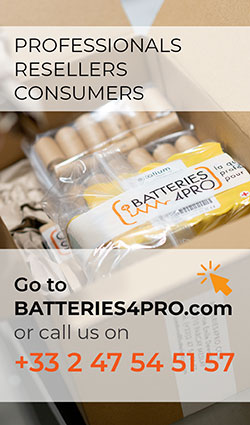![[DEVICEMED Magazine] Battery Technologies: How to Select the Right Cell for You?](/modules//smartblog/images/56-single-default.jpg)
Battery Technologies:
How do you select the right cell for you?
ISO 13485, ISO 14001 and ISO 9001 certified, the Touraine SME VLAD is a reference in France for custom-made medical batteries. Its industrial director, Stéphane Jaud, explains here the criteria for choosing a cell that makes up the battery of a DM.
Founded in 1985 north of Tours (37), VLAD now has nearly 90 employees who produce premium battery packs with state-of-the-art equipment for industry and the medical sector. The company also integrates
A design office dedicated to the design of custom batteries for its customers' applications.
"The rigour of our processes and the quality of our batteries are validated by a triple certification: ISO 9001:2015 for quality, ISO14001:2015 for the environment and, above all, ISO 13485:2016 for medical devices," explains Stéphane Jaud. "We set ourselves this high standard for quality because our batteries are integrated into life-saving devices. There is always a patient at the end of the line. The major players in the medical system, as well as the technical services closest to patients, rely on us in terms of quality and availability."
ESSENTIAL POINTS TO SHARE BEFORE CHOOSING YOUR CELL
Remember that a battery consists of an assembly of cells, which are either batteries (non-rechargeable) or accumulators (rechargeable).
"We are not manufacturers of cells, but of batteries," says Stéphane Jaud. "In this way, we retain all our independence and objectivity to offer the most suitable cell technology for the use of a given device."
LiMNO2, Li-SOCl2, LiFePO4, NiMh, NCA, NMC... It's easy to get lost in the chemical compositions of cells. Choosing the right one starts with understanding how your device works and how it is used!
"We will define together, with the manufacturer, whether we go with a primary (battery) or secondary (rechargeable) solution. We will identify 4 phases in the life of the battery: charging (if they are accumulators), discharge, storage and recycling (or reconditioning). Regardless of the cartridge, you should expect to have to make compromises: will I prioritize range or power? »
All technologies have advantages and disadvantages. In a first step, several parameters will be compared between the applicants: the density energy density (Wh/l), the mass energy density (Wh/kg), the nominal voltage (V), the number of cycles, the temperature range (°C), the self-discharge (%/month), the maximum permissible current in charge/discharge (A) and the internal impedance (mΩ).
Will the battery work in "Cycling" or "Backup" mode? "This will have an impact on the charging method to be designed," explains Stéphane Jaud. "Don't forget to specify whether the device will have multiple power sources."
It is also important to clearly identify the intended marketing areas for the devices as the normative requirements may vary.
Transport and packaging rules can be more or less restrictive depending on the mode of transport chosen, the electrochemistry selected for the cells and the electrical energy level of the battery (Wh). "VLAD provides its clients with support that is as close as possible to legislation," says Stéphane Jaud.
THE IMPORTANCE OF THE CONSUMPTION PROFILE
The consumption profile of the application must remain compatible with the chosen technology. A battery will have a constant voltage, high internal resistance, limited discharge currents but much lower self-discharge than a battery. On the other hand, an accumulator will have a variable voltage; It will be necessary to check the technical consistency with the voltage window of the input stage.
Several questions arise: will the application operate in a "power", "current" or "resistance" mode, according to a constant or pulsed profile?
With accumulators, in power mode, the level of current flow will vary depending on the voltage of the battery. It will be necessary to take the worst-case scenario to size the cell and the associated safeguards.
"Battery manufacturers only give the impedance at 1 kHz," notes Stéphane Jaud. "It's not necessarily the frequency for the application in question. But, in this case, we know how to provide the complementary elements. Cell manufacturers trust us because we take care to integrate their electrical safety requirements and mechanical constraints," adds Stéphane Jaud.
"It's a guarantee of a good partnership. We will also try not to move towards a single-source solution. We will select a cell reference in line with the operating life of the device. It is better to be associated from the very beginning of the project because the shape of the pack will affect its performance and industrialization."

Stéphane JAUD
VLAD Industrial Director









































![[LES ECHOS] VLAD: greener and cheaper batteries by focusing on people and Industry 4.0](/modules//smartblog/images/59-home-small.jpg)
![[DEVICEMED Magazine] Battery Technologies: How to Select the Right Cell for You?](/modules//smartblog/images/56-home-small.jpg)

